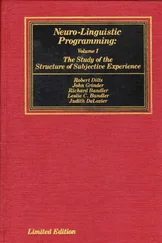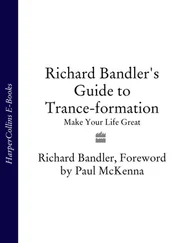Now the interesting thing is that if you ask someone to describe her normal state of consciousness and then to describe what it's like to be in an altered state, she'll often use a different representational system. For example, someone might describe her normal state as "having a clear, focused sense of who I am" (visual words), and her altered state as being "in touch with the universe" (kinesthetic words).
This means that when you find out what state someone is in normally in terms of representational systems, you have an excellent indication of what would be an altered state for that person— anything else. If someone comes in who is really in touch with her feelings and has a firm grasp on her life, you might want to take her to an altered state where she is primarily aware of visual images. So if she came in and said "Well, I just feel like I want to go into a trance, because I'm in touch with having a lot of needs, and I get irritated sometimes, and I want to feel relaxed and smooth out some of the difficulties in my life" I would have a subtle indication that her awareness is mostly kinesthetic.
Jan, would you come up here a minute? Tell me something you like about your house.
Jan: Oh, I love the view. I've got a place overlooking the ocean—it's just beautiful.
She is offering me visual information, so I know I'm safe if I begin talking about visual information. That will pace her experience. Remember, the meta–pattern is pacing and leading: matching what the client is already doing and then leading to something else. That "something else" is to go to systems which she doesn't ordinarily use. That will be an altered state for her.
I'd probably begin by asking for a context that is visually pleasing. I already know Jan likes the view of the ocean. Do you like the beach?
Jan: Oh, yes!
I would like to invite you, with your eyes open or closed, to follow along with me as I offer you a description of the experience … of being at the ocean. … If you were actually able … to go to the ocean … on a day like today … one of the first things that you can become aware of… is that as you look up … you see clearly … the distinctive lighting of the sky… . You may be able to see some clouds floating across the sky … and as you look about … you can enjoy … the clarity of the air … and you glance down and see … the surface of the beach … and as you stand there … looking down at the beach you're standing on … you can see your feet … and you can feel … the feeling … of your feet … on the beach… .
And when you look out across . , . the ocean … you can see wave … after wave … after wave … rolling from the horizon … toward you … each one having a unique form …a particular curl …a particular color as it splashes… . And as you look out at the waves … moving in … you notice … the wind is blowing some of the spray off the top of each wave as the breaker hits the shore… . And as you watch that spray, you can feel … the moisture in the air, . . as the breeze blows on your face… . And if you were to
now take … a couple of steps … into the water … and feel the coolness of the water swirling around your feet … and ankles … and you can really enjoy it. …
Now if you look up or down along the beach, you can see a familiar figure … someone you had not expected to find there … and you wave … and that person calls across to you … reminding you of another time and place … and something rather pleasant and surprising … that came from that experience … and enjoy the experience … and learn … from it … whatever might be useful for you… . And when you are prepared … and have enjoyed them … at your own rate … taking all the time you desire … come back.…
Now, what form of communication was I using?
Woman: You seemed to be using primarily visuals and a lot of going back and forth between those and kinesthetics. Did you reach a point where you decided to stay in kinesthetics?
I would have if I had continued the induction. When I go back and forth, I'm testing to find out if she can follow. Think of this as a verbal counterpart of breathing together. I breathe with her for a while and then I alter my breathing. If she follows, I now. have rapport; I have the lead and can continue to develop whatever kind of experience is appropriate.
How did I know that she was able to follow me, by the way? After I said the first few things, I knew immediately that she was able to go along with me. How did I know that? ' Man: Her head moved congruently with your instructions.
Yes. When I talked about looking up, her head moved up. When I talked about looking down, her head moved down. When I talked 1about looking out at the waves, she looked out at the waves. Her body responses indicated that she was having the experience I was suggesting. That is enough information to know that I have rapport. Now, the question is: do I still have rapport if I switch systems? Answer: try it and find out. So I had her look down at the beach. Then I said "And feel your feet against the sand," Jan: I did.
Woman: So then when you get her into another system, do you tend to stay there?
Yes. Then I would talk mainly about the sensations in her body. As she steps into the water, she can feel the swirling of the water … and the moisture inthear… as the wind blows against her face.
I first develop a visual image about where she is and then find a point of overlap between the visual image and any other system. So, in this case, if she looks down at the beach and sees her feet against the sand, then she can feel the firmness of her feet upon the beach. If she looks cut and sees the wind blowing spray off the top of the breaking waves, then she can feel the breeze against her face.
There is always a visual, an auditory, and a kinesthetic dimension to every experience. So you begin with whatever representational system the person offers you. That's pacing: joining the client's model. Then you can use a simple verbal formula which is "You see the clouds moving across the sky … and as you watch the clouds move, you feel the breeze against your face." Seeing the clouds moving suggests wind.
The point of overlap between the visual image of clouds moving, driven by the wind, and the kinesthctic system I want to lead her to is
the feeling of the breeze upon her face. The verbal formula is "as X," which is the pace, "Y," the lead.
Woman: You only used auditory once that I was aware of. You said she could hear the friend calling to her. Is there a reason why you did not emphasize auditory?
I didn't need it. In this culture the auditory system is seldom well–developed except in musicians. There were lots of other places where I '-could have included auditory elements: the sound of the wind, the sound of the waves breaking against the shore.
I want to distinguish between induction and utilization. An induction of going visual–visual–visual, then overlapping to kinesthetic, and .when she follows, continuing with kinesthetic, will radically alter her state of consciousness. Once that has happened, and I've got all those physiological signs that we were talking about earlier, then all I have to do is build a full experience again. Then I would include all three 'systems. I would have her walk up to the person, reach out, touch the person, look carefully at his or her face and notice what expression is there, and then listen to what the person has to tell her. Then I would use that fantasy with all three representational systems as the matrix for whatever changes she wants to achieve. Woman: There was an auditory interruption. Somebody's tape recorder clicked loudly, and I was wondering why you didn't utilize that. It certainly interrupted you.
Читать дальше











